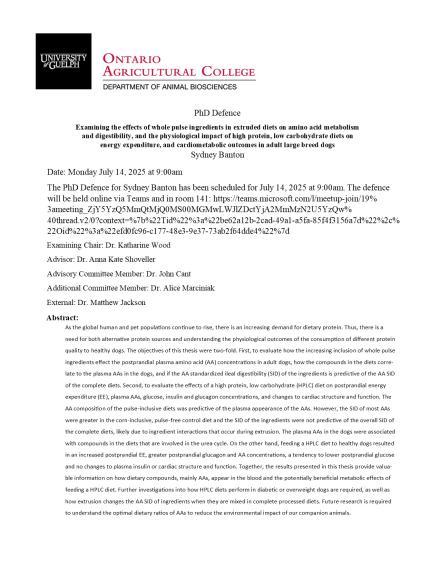Sydney Banton's PhD Defence
Date and Time
Location
ANNU 141 and on Teams: https://teams.microsoft.com/l/meetup-join/19%3ameeting_ZjY5YzQ5MmQtMjQ0MS00MGMwLWJlZDctYjA2MmMzN2U5YzQw%40thread.v2/0?context=%7b%22Tid%22%3a%22be62a12b-2cad-49a1-a5fa-85f4f3156a7d%22%2c%22Oid%22%3a%22efd0fc96-c177-48e3-9e37-73ab2f64dde4%22%7d

Details
Examining the effects of whole pulse ingredients in extruded diets on amino acid metabolism and digestibility, and the physiological impact of high protein, low carbohydrate diets on energy expenditure, and cardiometabolic outcomes in adult large breed dogs
As the global human and pet populations continue to rise, there is an increasing demand for dietary protein. Thus, there is a need for both alternative protein sources and understanding the physiological outcomes of the consumption of different protein quality to healthy dogs. The objectives of this thesis were two-fold. First, to evaluate how the increasing inclusion of whole pulse ingredients effect the postprandial plasma amino acid (AA) concentrations in adult dogs, how the compounds in the diets correlate to the plasma AAs in the dogs, and if the AA standardized ileal digestibility (SID) of the ingredients is predictive of the AA SID of the complete diets. Second, to evaluate the effects of a high protein, low carbohydrate (HPLC) diet on postprandial energy expenditure (EE), plasma AAs, glucose, insulin and glucagon concentrations, and changes to cardiac structure and function. The AA composition of the pulse-inclusive diets was predictive of the plasma appearance of the AAs. However, the SID of most AAs were greater in the corn-inclusive, pulse-free control diet and the SID of the ingredients were not predictive of the overall SID of the complete diets, likely due to ingredient interactions that occur during extrusion. The plasma AAs in the dogs were associated with compounds in the diets that are involved in the urea cycle. On the other hand, feeding a HPLC diet to healthy dogs resulted in an increased postprandial EE, greater postprandial glucagon and AA concentrations, a tendency to lower postprandial glucose and no changes to plasma insulin or cardiac structure and function. Together, the results presented in this thesis provide valuable information on how dietary compounds, mainly AAs, appear in the blood and the potentially beneficial metabolic effects of feeding a HPLC diet. Further investigations into how HPLC diets perform in diabetic or overweight dogs are required, as well as how extrusion changes the AA SID of ingredients when they are mixed in complete processed diets. Future research is required to understand the optimal dietary ratios of AAs to reduce the environmental impact of our companion animals.